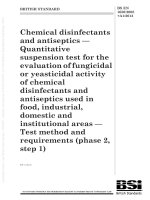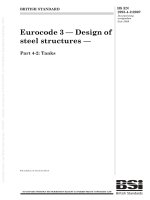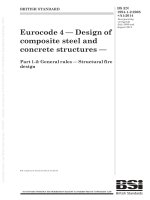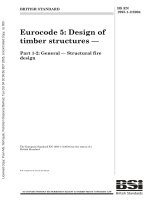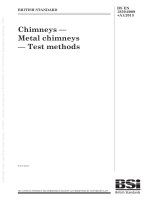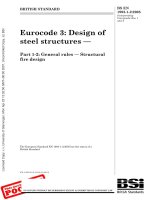Bsi bs en 61753 058 2 2013
Bạn đang xem bản rút gọn của tài liệu. Xem và tải ngay bản đầy đủ của tài liệu tại đây (1.24 MB, 26 trang )
BS EN 61753-058-2:2013
BSI Standards Publication
Fibre optic interconnecting
devices and passive
components — Performance
standard
Part 058-2: Single mode fibre pigtailed
style optical power limiter for category C —
Controlled environment
BRITISH STANDARD
BS EN 61753-058-2:2013
National foreword
This British Standard is the UK implementation of EN 61753-058-2:2013. It
is identical to IEC 61753-058-2:2013.
The UK participation in its preparation was entrusted by Technical
Committee GEL/86, Fibre optics, to Subcommittee GEL/86/2, Fibre optic
interconnecting devices and passive components.
A list of organizations represented on this committee can be obtained on
request to its secretary.
This publication does not purport to include all the necessary provisions of
a contract. Users are responsible for its correct application.
© The British Standards Institution 2013
Published by BSI Standards Limited 2013
ISBN 978 0 580 70068 2
ICS 33.180.20
Compliance with a British Standard cannot confer immunity from
legal obligations.
This British Standard was published under the authority of the
Standards Policy and Strategy Committee on 31 July 2013.
Amendments issued since publication
Amd. No.
Date
Text affected
BS EN 61753-058-2:2013
EN 61753-058-2
EUROPEAN STANDARD
NORME EUROPÉENNE
EUROPÄISCHE NORM
June 2013
ICS 33.180.20
English version
Fibre optic interconnecting devices and passive components Performance standard Part 058-2: Single mode fibre pigtailed style optical power limiter
for category C - Controlled environment
(IEC 61753-058-2:2013)
Dispositifs d'interconnexion et composants
passifs à fibres optiques Norme de performance Partie 058-2: Limiteur de puissance
optique de type fibre amorce, à fibre
unimodale pour catégorie C Environnement contrôlé
(CEI 61753-058-2:2013)
Lichtwellenleiter Verbindungselemente und passive
Bauteile Betriebsverhalten Teil 058-2: Optischer Leistungsbegrenzer
mit Anschlussfaser für Einmodenfasern
der Kategorie C Kontrollierte Umgebung
(IEC 61753-058-2:2013)
This European Standard was approved by CENELEC on 2013-04-22. CENELEC members are bound to comply
with the CEN/CENELEC Internal Regulations which stipulate the conditions for giving this European Standard
the status of a national standard without any alteration.
Up-to-date lists and bibliographical references concerning such national standards may be obtained on
application to the CEN-CENELEC Management Centre or to any CENELEC member.
This European Standard exists in three official versions (English, French, German). A version in any other
language made by translation under the responsibility of a CENELEC member into its own language and notified
to the CEN-CENELEC Management Centre has the same status as the official versions.
CENELEC members are the national electrotechnical committees of Austria, Belgium, Bulgaria, Croatia, Cyprus,
the Czech Republic, Denmark, Estonia, Finland, Former Yugoslav Republic of Macedonia, France, Germany,
Greece, Hungary, Iceland, Ireland, Italy, Latvia, Lithuania, Luxembourg, Malta, the Netherlands, Norway, Poland,
Portugal, Romania, Slovakia, Slovenia, Spain, Sweden, Switzerland, Turkey and the United Kingdom.
CENELEC
European Committee for Electrotechnical Standardization
Comité Européen de Normalisation Electrotechnique
Europäisches Komitee für Elektrotechnische Normung
Management Centre: Avenue Marnix 17, B - 1000 Brussels
© 2013 CENELEC -
All rights of exploitation in any form and by any means reserved worldwide for CENELEC members.
Ref. No. EN 61753-058-2:2013 E
BS EN 61753-058-2:2013
EN 61753-058-2:2013
-2-
Foreword
The text of document 86B/3552/FDIS, future edition 1 of IEC 61753-058-2, prepared by SC 86B "Fibre
optic interconnecting devices and passive components” of IEC/TC 86 “Fibre optics" was submitted to
the IEC-CENELEC parallel vote and approved by CENELEC as EN 61753-058-2:2013.
The following dates are fixed:
•
•
latest date by which the document has
to be implemented at national level by
publication of an identical national
standard or by endorsement
latest date by which the national
standards conflicting with the
document have to be withdrawn
(dop)
2014-01-22
(dow)
2016-04-22
Attention is drawn to the possibility that some of the elements of this document may be the subject of
patent rights. CENELEC [and/or CEN] shall not be held responsible for identifying any or all such
patent rights.
Endorsement notice
The text of the International Standard IEC 61753-058-2:2013 was approved by CENELEC as a
European Standard without any modification.
-3-
BS EN 61753-058-2:2013
EN 61753-058-2:2013
Annex ZA
(normative)
Normative references to international publications
with their corresponding European publications
The following documents, in whole or in part, are normatively referenced in this document and are
indispensable for its application. For dated references, only the edition cited applies. For undated
references, the latest edition of the referenced document (including any amendments) applies.
NOTE When an international publication has been modified by common modifications, indicated by (mod), the relevant EN/HD
applies.
Publication
Year
Title
EN/HD
Year
IEC 60869-1
-
Fibre optic interconnecting devices and
passive components - Fibre optic passive
power control devices Part 1: Generic specification
EN 60869-1
-
IEC 61300
Series Fibre optic interconnecting devices and
passive components - Basic test and
measurement procedures
EN 61300
Series
IEC 61300-1
-
Fibre optic interconnecting devices and
passive components - Basic test and
measurement procedures Part 1: General and guidance
EN 61300-1
-
IEC 61300-2-1
-
Fibre optic interconnecting devices and
passive components - Basic test and
measurement procedures Part 2-1: Tests - Vibration (sinusoidal)
EN 61300-2-1
-
IEC 61300-2-4
-
Fibre optic interconnecting devices and
passive components - Basic test and
measurement procedures Part 2-4: Tests - Fibre/cable retention
EN 61300-2-4
-
IEC 61300-2-9
-
Fibre optic interconnecting devices and
passive components - Basic test and
measurement procedures Part 2-9: Tests - Shock
EN 61300-2-9
-
IEC 61300-2-14
-
Fibre optic interconnecting devices and
passive components - Basic test and
measurement procedures Part 2-14: Tests - High optical power
EN 61300-2-14
-
IEC 61300-2-17
-
Fibre optic interconnecting devices and
passive components - Basic test and
measurement procedures Part 2-17: Tests - Cold
EN 61300-2-17
-
IEC 61300-2-18
-
Fibre optic interconnecting devices and
passive components - Basic test and
measurement procedures Part 2-18: Tests - Dry heat - High
temperature endurance
EN 61300-2-18
-
IEC 61300-2-19
-
Fibre optic interconnecting devices and
EN 61300-2-19
passive components - Basic test and
measurement procedures Part 2-19: Tests - Damp heat (steady state)
-
BS EN 61753-058-2:2013
EN 61753-058-2:2013
-4-
Publication
Year
Title
EN/HD
Year
IEC 61300-2-22
-
Fibre optic interconnecting devices and
passive components - Basic test and
measurement procedures Part 2-22: Tests - Change of temperature
EN 61300-2-22
-
IEC 61300-2-42
-
Fibre optic interconnecting devices and
passive components - Basic test and
measurement procedures Part 2-42: Tests - Static side load for
connectors
EN 61300-2-42
-
IEC 61300-3-2
-
Fibre optic interconnecting devices and
EN 61300-3-2
passive components - Basic test and
measurement procedures Part 3-2: Examinations and measurements Polarization dependent loss in a single-mode
fibre optic device
-
IEC 61300-3-3
-
Fibre optic interconnecting devices and
EN 61300-3-3
passive components - Basic test and
measurement procedures Part 3-3: Examinations and measurements Active monitoring of changes in attenuation
and return loss
-
IEC 61300-3-4
-
Fibre optic interconnecting devices and
EN 61300-3-4
passive components - Basic test and
measurement procedures Part 3-4: Examinations and measurements Attenuation
-
IEC 61300-3-6
-
Fibre optic interconnecting devices and
EN 61300-3-6
passive components - Basic test and
measurement procedures Part 3-6: Examinations and measurements Return loss
-
IEC 61300-3-7
-
Fibre optic interconnecting devices and
EN 61300-3-7
passive components - Basic test and
measurement procedures Part 3-7: Examinations and measurements Wavelength dependence of attenuation and
return loss of single mode components
-
IEC 61300-3-32
-
Fibre optic interconnecting devices and
EN 61300-3-32
passive components - Basic test and
measurement procedures Part 3-32: Examinations and measurements
- Polarisation mode dispersion measurement
for passive optical components
-
BS EN 61753-058-2:2013
–2–
61753-058-2 © IEC:2013
CONTENTS
INTRODUCTION ..................................................................................................................... 5
1
Scope ............................................................................................................................... 6
2
Normative references ....................................................................................................... 6
3
Tests ................................................................................................................................ 7
4
Test reports ...................................................................................................................... 7
5
Performance requirements ............................................................................................... 7
5.1
5.2
5.3
Annex A
Sample size, sequencing and grouping.................................................................... 7
Dimensions ............................................................................................................. 7
Test details and requirements ................................................................................. 8
(normative) Sample size and product sourcing requirements ................................. 14
Annex B (normative) P limit definition .................................................................................... 15
Annex C (normative) Response time definition ..................................................................... 16
Annex D (normative) Maximum allowed power input for optical limiters, single-mode ........... 17
Annex E (informative) Example of dimensions for optical limiters ......................................... 18
Annex F (normative) Testing of optical limiters ..................................................................... 19
Figure B.1 – Measurements of P out as a function of P in ........................................................ 15
Figure C.1 – Definition of response time ............................................................................... 16
Figure E.1 – Optical limiter, in-line configuration, regularly without connectors .................... 18
Figure F.1 – P limit Test set-up schematics ............................................................................ 19
Figure F.2 – Response time testing set-up ............................................................................ 20
Table 1 – Performance requirements for optical power limitersn (1 of 6) ................................. 8
Table A.1 – Sample size and product sourcing requirements ................................................ 14
Table D.1 – Maximum allowed power input for optical limiters, single-mode .......................... 17
BS EN 61753-058-2:2013
61753-058-2 © IEC:2013
–5–
INTRODUCTION
1) The International Electrotechnical Commission (IEC) draws attention to the fact that it is
claimed that compliance with this document may involve the use of a patent concerning
power limiters, registered as follows:
Country
Israel
Patent number
147554
European Union
EP 1467239 A2
USA
USP110/398'859
Japan
4587695
Canada
24649043
IEC takes no position concerning the evidence, validity and scope of this patent right.
The holder of this patent right has assured the IEC that he/she is willing to negotiate
licences under reasonable and non-discriminatory terms and conditions with applicants
throughout the world. In this respect, the statement of the holder of this patent right is
registered with IEC. Information may be obtained from:
KiloLambda technologies, Ltd.
22a Raoul Wallenberg street,
Tel-Aviv 69719, Israel
Attention is drawn to the possibility that some of the elements of this document may be the
subject of patent rights other than those identified above. IEC shall not be held
responsible for identifying any or all such patent rights.
ISO (www.iso.org/patents) and IEC () maintain on-line data bases of
patents relevant to their standards. Users are encouraged to consult the data bases for
the most up to date information concerning patents.
2) The optical power limiter is a passive device that regulates the optical power in fibres,
producing a controlled, constant output power P limit , as a result of varying input power
higher than P limit , and has no influence at powers below P limit . Under normal operation,
when the input power is low, the optical power limiter has no effect on the system.
However, when the input power is high, the optical output power is limited to a
predetermined level (P limit ).The optical limiter is wavelength independent over its entire
specified spectral range. IEC 60869-1 contains the generic information of the optical
power limiter . The optical power limiter is used at the input of power-sensitive equipment
and at the output of high power devices, such as amplifiers, or wherever power regulation
is required. The optical power limiter can serve as an eye safety device. The optical power
limiter has a maximal allowed optical power P in max. Above this power the optical limiter
can melt down and open a through path for light. Numerical values for P in max are given in
Annex D.
BS EN 61753-058-2:2013
–6–
61753-058-2 © IEC:2013
FIBRE OPTIC INTERCONNECTING DEVICES AND
PASSIVE COMPONENTS – PERFORMANCE STANDARD –
Part 058-2: Single mode fibre pigtailed style optical
power limiter for category C – Controlled environment
1
Scope
This part of IEC 61753 contains the minimum initial test and measurement requirements and
severities which an optical power limiter needs to satisfy in order to be categorized as
meeting the requirements of single mode fibre pigtailed style optical power limiter used in
controlled environments. Optical performance specified in this standard relates to in-line type
configuration power limiters only.
2
Normative references
The following documents, in whole or in part, are normatively referenced in this document and
are indispensable for its application. For dated references, only the edition cited applies. For
undated references, the latest edition of the referenced document (including any
amendments) applies.
IEC 60869-1, Fibre optic interconnecting devices and passive components – Fibre optic
passive power control devices – Part 1: Generic specification
IEC 61300 (all parts), Fibre optic interconnecting devices and passive components – Basic
test and measurement procedures
IEC 61300-1, Fibre optic interconnecting devices and passive components – Basic test and
measurement procedures – Part 1: General and guidance
IEC 61300-2-1, Fibre optic interconnecting devices and passive components – Basic test and
measurement procedures – Part 2-1: Tests – Vibration (sinusoidal)
IEC 61300-2-4, Fibre optic interconnecting devices and passive components – Basic test and
measurement procedures – Part 2-4: Tests – Fibre/cable retention
IEC 61300-2-9, Fibre optic interconnecting devices and passive components – Basic test and
measurement procedures – Part 2-9: Tests – Shock
IEC 61300-2-14, Fibre optic interconnecting devices and passive components – Basic test
and measurement procedures – Part 2-14: Tests – High optical power
IEC 61300-2-17, Fibre optic interconnecting devices and passive components – Basic test
and measurement procedures – Part 2-17: Tests – Cold
IEC 61300-2-18, Fibre optic interconnecting devices and passive components – Basic test
and measurement procedures – Part 2-18: Tests – Dry heat – High temperature endurance
IEC 61300-2-19, Fibre optic interconnecting devices and passive components – Basic test
and measurement procedures – Part 2-19: Tests – Damp heat (steady state)
BS EN 61753-058-2:2013
61753-058-2 © IEC:2013
–7–
IEC 61300-2-22, Fibre optic interconnecting devices and passive components – Basic test
and measurement procedures – Part 2-22: Tests – Change of temperature
IEC 61300-2-42, Fibre optic interconnecting devices and passive components – Basic test
and measurement procedures – Part 2-42: Tests – Static side load for connectors
IEC 61300-3-2, Fibre optic interconnecting devices and passive components – Basic test and
measurement procedures – Part 3-2: Examination and measurements – Polarization
dependent loss in a single-mode fibre optic device
IEC 61300-3-3, Fibre optic interconnecting devices and passive components – Basic test and
measurement procedures – Part 3-3: Examinations and measurements – Active monitoring of
changes in attenuation and return loss
IEC 61300-3-4, Fibre optic interconnecting devices and passive components – Basic test and
measurement procedures – Part 3-4: Examinations and measurements –Attenuation
IEC 61300-3-6, Fibre optic interconnecting devices and passive components – Basic test and
measurement procedures – Part 3-6: Examinations and measurements – Return loss
IEC 61300-3-7, Fibre optic interconnecting devices and passive components – Basic test and
measurement procedures – Part 3-7: Examinations and measurements – Wavelength
dependence of attenuation and return loss of single mode components
IEC 61300-3-32, Fibre optic interconnecting devices and passive components – Basic test
and measurement procedures – Part 3-32: Examinations and measurements – Polarization
mode dispersion measurement for passive optical components
3
Tests
All test methods are in accordance with the IEC 61300 series.
All tests shall be carried out to validate performance over the required operating wavelength
and power range.
4
Test reports
Fully documented test reports and supporting evidence shall be prepared and shall be
available for inspection as evidence that the tests have been carried out and complied with
relevant requirements.
5
5.1
Performance requirements
Sample size, sequencing and grouping
Sample sizes for the tests are defined in Annex A.
Test groups shall be performed as shown in Annex A.
5.2
Dimensions
Dimensions shall comply with either an appropriate IEC interface standard or with those given
in appropriate manufacturers drawings, where the IEC interface standard does not exist or
cannot be used.
BS EN 61753-058-2:2013
–8–
5.3
61753-058-2 © IEC:2013
Test details and requirements
Table 1 specifies the optical, environmental and mechanical performance requirements and
related test methods for optical power limiters.
Compliance to this standard requires demonstration of the ability to meet the relevant
performance requirement in Table 1.
Table 1 – Performance requirements for optical power limiters (1 of 6)
No.
Tests
Requirements
1
Insertion loss
Operating wavelength
range: 1 520 nm-1 625 nm
Method:
IEC 61300-3-7, method B.2.1. Test
sample configuration in accordance with
IEC 61300-3-4, substitution method.
Launch patchcord
length:
≥ 2 m. Only the fundamental mode shall
propagate at the optical power limiter
interface and at the detector.
Launch
conditions:
The wavelength of the source shall be
longer than cut-off wavelength of the fibre
Source power
stability:
≤ ± 0,05 dB over the measuring period
or at least 1 h
Wavelength
range:
1 520 nm to 1 625 nm
Total uncertainty:
≤ ± 0,05 dB
Method:
IEC 61300-3-6, Method 1 OCWR
Optical source
wavelength:
1 520 nm and 1 625 nm
Total uncertainty:
≤ ± 2 dB over the dynamic range
to be measured
≤ 0,2 dB
Method:
IEC 61300-3-2, all polarization method
Over the specified
operating wavelength
range.
Optical source
wavelength:
1 550 nm ± 10 nm
Total uncertainty:
≤ ± 0,05 dB over the dynamic range
to be measured
≤ 0,2 ps
Method:
IEC 61300-3-32, MPS method
Over the specified
operating wavelength
range.
Optical source
wavelength:
1 550 nm ± 10 nm
Measurements carried out
only in low power
≤ –5 dBm
Total uncertainty:
≤ ± 0,05 dB over the dynamic range
to be measured
Insertion loss:
≤ 2 dB for P limit > 9 dBm
≤ 5 dB for 0 dBm ≤ P limit
≤ 9 dBm
≤ 7 dB for P limit ≤ 0 dBm
Insertion loss is measured
with input power
≤ –5 dBm. This power level
is always below P limit at the
linear behaviour of the
limiter
2
Return loss
Up to P limit : ≥ 40 dB return
loss is measured with input
power ≤ –5 dBm. This
power level is always
below P limit , at the linear
behaviour of the limiter.
Above P limit : ≥ 30 dB
return loss is measured
with input power of + 3 dB
above P limit
3
Polarization
dependent
loss
Measurements carried out
only in low power
≤ –5 dBm
4
Polarization
mode
dispersion
Details
Test every sample with the two
wavelengths
BS EN 61753-058-2:2013
61753-058-2 © IEC:2013
–9–
Table 1 (2 of 6)
No.
5
Tests
High optical
power
Requirements
Details
Before and after the test,
the insertion loss shall
meet the requirements of
test 1.
Method:
Future IEC 61300-2-14: Full
characterization at a specific wavelength
Test temperature:
25 °C ± 2 °C
Before and after the test,
the return loss shall meet
the requirements of test 2
Power loads for
testing:
For P limit ≤ 10 dBm:
P limit + 5 dB for continuous wave (CW)
operation, tested for 96 h
P limit + 8 dB for short bursts, up to
1 s/min for 1 h
For P limit > 10 dBm:
P limit + 3 dB for CW operation, tested
for 96 h
P limit + 5 dB for short bursts, up to
1 s/min for 1 h
6
Limit power
P limit as specified ±
0,5 dB.
P limit example is shown in
Annex B.
The limiter will meet the
limit power requirements
as specified in Annex D,
when operated at the 3
specified temperatures.
This test uses a slowly
varying optical power
source starting at –5 dBm
and up to +8 dB above
P limit , giving results of
insertion loss and P limit
for the whole range of
input powers
Optical source
wavelength:
1 550 nm
Test duration:
Duration of long-term test: 96 h at max.
power. For short bursts, up to 1 s/ min
Launch patchcord
length and launch
conditions:
Same as test No. 1
Method:
See Annex F
Source:
Slowly varying optical power source from
–5 dBm and up to +8 dB above P limit
Optical source
wavelength:
1 550 nm
Optical source
power increment:
100 mW power increments, at a rate of 1
increment of 100 mW/s
Test temperature:
10 °C ± 2 °C
25 °C ± 2 °C
60 °C ± 2 °C
Detector system:
Linearity within ± 0,05 dB.
Spectral response matched to source.
Dynamic range between –5 dBm to +8 dB
above P limit
Launch patchcord Same as test No. 1
length and Launch
conditions:
BS EN 61753-058-2:2013
– 10 –
61753-058-2 © IEC:2013
Table 1 (3 of 6)
No.
Tests
7
Response time
Requirements
Details
500 µs ± 10 µs
Method:
Response time example
see Annex C.
Optical source:
The limiter will meet the
requirements as specified
when operated at the 3
specified temperatures
See Annex F
Laser source having adjustable power up
to 8 dB above P limit
Square wave input power, having rise
time of 10 µs
Optical source
wavelength:
1 550 nm
Test temperature:
10 °C ± 2 °C
25 °C ± 2 °C
60 °C ± 2 °C
Launch patchcord Same as test No.1
length and Launch
conditions:
8
Damp heat
(steady state)
Before and after the test
the insertion loss shall
meet the requirements of
test 1.
Before and after the test
the return loss shall meet
the requirements of test 2.
Method:
IEC 61300-2-19
During the test, the change in insertion
loss shall be measured by test method
IEC 61300-3-3.
Pre conditioning
procedure:
Standard atmospheric conditions as
defined in IEC 61300-1 for 2 h.
The insertion loss change
during the test shall be
within ± 0,5 dB of the
initial value .
Temperature:
+40 ± 2 °C
Relative humidity:
93 + 2 %
Above measurements
carried out in power
≤ –5 dBm
Duration of
exposure:
96 h
Specimen
optically
functioning:
Yes
Optical source
wavelength:
1 550 nm
Recovery
procedure:
Allow specimens to return to standard
atmospheric conditions as defined in
IEC 61300-1 in 2 h
Before and after the test
the P limit shall meet the
requirements of test 6
−3
BS EN 61753-058-2:2013
61753-058-2 © IEC:2013
– 11 –
Table 1 (4 of 6)
No.
9
Tests
Change of
temperature
Requirements
Before and after the test
the insertion loss shall
meet the requirements of
test 1.
Before and after the test
the return loss shall meet
the requirements of test 2.
10
Dry heat –
High
temperature
endurance
Details
Method:
IEC 61300-2-22
During the test the change in insertion
loss shall be measured by test method
IEC 61300-3-3.
Pre conditioning
procedure:
Standard atmospheric conditions as
defined in IEC 61300-1 for 2 h.
The insertion loss change
during the test shall be
within ± 0,5 dB of the
initial value. The above
measurements are carried
out at a power of
≤ –5 dBm.
High
temperature:
+60 ± 2 °C
Low temperature:
–10 ± 2 °C
Duration at
extreme
temperature:
1h
Before and after the test,
the P limit shall meet the
requirements of test 6
Temperature rate
of change:
1 °C/min
Number of
cycles:
5
Specimen
optically
functioning:
Yes
Maximum
sampling interval
during the test:
15 min
Optical source
wavelength:
1 550 nm
Recovery
procedure:
Allow specimens to return to standard
atmospheric conditions as defined in
IEC 61300-1 in 2 h
Before and after the test
the insertion loss shall
meet the requirements of
test 1.
Before and after the test
the return loss shall meet
the requirements of test 2
The insertion loss change
during the test shall be
within ± 0,5 dB of the
initial value. The above
measurements carried out
at a power of ≤ –5 dBm.
Before and after the test
the P limit shall meet the
requirements of test 6
Method:
IEC 61300-2-18.
During the test the change in insertion
loss shall be measured by test method
IEC 61300-3-3.
Pre conditioning
procedure:
Standard atmospheric conditions as
defined in IEC 61300-1 for 2 h.
High
temperature:
+60 ± 2 °C
Duration at
extreme
temperature:
96 h
Maximum
sampling interval
during the test:
1h
Specimen
optically
functioning:
Yes
Optical source
wavelength:
1 550 nm
Recovery
procedure:
Allow specimens to return to standard
atmospheric conditions as defined in
IEC 61300-1 within 2 h
BS EN 61753-058-2:2013
– 12 –
61753-058-2 © IEC:2013
Table 1 (5 of 6)
No.
11
Tests
Cold
Requirements
Before and after the test
the insertion loss shall
meet the requirements of
test 1.
Before and after the test
the return loss shall meet
the requirements of test 2.
The insertion loss change
during the test shall be
within ± 0,5 dB of the
initial value. The above
measurements carried out
at a power of
≤ –5 dBm.
Before and after the test
the P limit shall meet the
requirements of test 6
12
Vibration
(sinusoidal)
Before and after the test
the insertion loss shall
meet the requirements of
test 1.
Before and after the test
the return loss shall meet
the requirements of test 2.
Above measurements
carried out at a power of
≤ –5 dBm.
Before and after the test
the P limit shall meet the
requirements of test 6
Details
Method:
IEC 61300-2-17.
During the test, the change in insertion
loss shall be measured by test method
IEC 61300-3-3.
Pre conditioning
procedure:
Standard atmospheric conditions as
defined in IEC 61300-1 for 2 h
Low temperature:
–10 ± 2 °C
Duration at
extreme
temperature:
96 h
Specimen
optically
functioning:
Yes
Optical source
wavelength:
1 550 nm
Maximum
sampling interval
during the test:
1h
Recovery
procedure:
Allow specimens to return to standard
atmospheric conditions as defined in
IEC 61300-1 in 2 h
Method:
IEC 61300-2-1.
During the test, the change in insertion
loss shall be measured by test method
IEC 61300-3-3.
Frequency range:
10 Hz – 55 Hz
Vibration
amplitude:
0,75 mm
Number of
cycles:
15
Rate of change:
1 octave/min
Number of axes:
3 orthogonal axes
Specimen
optically
functioning:
No
Optical source
wavelength::
1 550 nm
BS EN 61753-058-2:2013
61753-058-2 © IEC:2013
– 13 –
Table 1 (6 of 6)
No.
13
Tests
Shock
Requirements
Insertion loss change
between value before test
and value after test shall
be within ± 0,5 dB of the
initial value.
Method:
IEC 61300-2-9
Acceleration
force
500 g
Number of axes:
3 axes, 2 directions
Before and after the test
the return loss shall meet
the requirements of test 2.
Number of
cycles:
2 shocks per direction, 12 shocks total
Above measurements
carried out at a power of
≤ –5 dBm.
Duration oer axis:
Nominal 1 ms duration, half sine pulse
Measurements
required:
Before, after each axis and after the test
Specimen
optically
functioning:
No
Optical source
wavelength
1 550 nm
Method:
IEC 61300-2-42
Magnitude of the
load:
1 N for 1 h for reinforced cable. 0,2 N for
5 min for secondary coated fibres
Rate of load
application:
0,5 N/s
Load application
point:
0,3 m from the end of the device and two
mutually perpendicular directions as
permitted by the product design
Specimen
optically
functioning
No
Optical source
wavelength:
1 550 nm
Method:
IEC 61300-2-4
Magnitude of the
load:
10 N ± 1 N at 5 N/s for reinforced cables
Before and after the test
the P limit shall meet the
requirements of test 6
14
Static side
load a
Insertion loss change
between value before test
and value after test shall
be within ± 0,5 dB of the
initial value.
Before and after the test
the return loss shall meet
the requirements of test 2
Above measurements
carried out in power
≤ –5 dBm
Before and after the test
the P limit shall meet the
requirements of test 6
15
Fibre/cable
retention
Details
Before and after the test
the insertion loss shall
meet the requirements of
test 1.
Before and after the test
the return loss shall meet
the requirements of test 2
The insertion loss change
during the test shall be
within ±0,5 dB of the initial
value . Above measurements carried out in power
≤ –5 dBm.
Before and after the test
the P limit shall meet the
requirements of test 6
a
5,0 N ± 0,5 N at 0,5 N/s for secondary
coated fibres
2,0 N ± 0,2 N at 0,5 N/s for primary coated
fibres
Load application
point:
0,3 m from point where the fibre/cable
exits from the specimen
Duration of the
load:
120 s duration at 10 N
Method of
mounting:
The sample shall be rigidly mounted such
that the load is only applied to the
fibre/cable retention mechanism
Specimen
optically
functioning:
Yes
Optical source
wavelength:
1 550 nm
60 s duration at 2 N or 5 N
Static side load shall be applied in two mutually perpendicular directions as permitted by the product design.
For example, a product with a base plate extending beyond the fibre exit may prohibit loading in that
direction.
BS EN 61753-058-2:2013
– 14 –
61753-058-2 © IEC:2013
Annex A
(normative)
Sample size and product sourcing requirements
Table A.1 gives sample size and product sourcing requirements.
Table A.1 – Sample size and product sourcing requirements
No.
Test
Sample size
Source
N/A
Dimensional
10
New
1
Insertion loss
48
New
2
Return loss
48
Test 1
3
Polarization dependent loss
48
Test 2
4
Polarization mode dispersion
4
Test 3
5
High optical power
4
Test 4
6
Limit power
4
Test 3
7
Response time
4
Test 3
8
Damp heat (steady state)
4
Test 3
9
Change of temperature
4
Test 3
10
Dry heat – High temperature endurance
4
Test 3
11
Cold
4
Test 3
12
Vibration (sinusoidal)
4
Test 3
13
Shock
4
Test 3
14
Static side load
4
Test 3
15
Fibre/cable retention
4
Test 3
NOTE Tests 5 to 15 may be performed in any order. Samples for tests 5 to 15
should be randomly selected from the samples of test 3.
BS EN 61753-058-2:2013
61753-058-2 © IEC:2013
– 15 –
Annex B
(normative)
Plimit definition
P limit is defined as the average between P out max and P out min of two consecutive
measurements,, one after the other, of P out as a function of P in , as depicted in Figure B.1,
where P in max is the maximal allowed power into the optical power limiter according to
Table D.1.
Pout
Pout max
Pout min
Pin max –3 dB
Pin max
Pin (dBm)
IEC 487/13
Figure B.1 – Measurements of P out as a function of P in
BS EN 61753-058-2:2013
– 16 –
61753-058-2 © IEC:2013
Annex C
(normative)
Response time definition
Response time is the total time where the optical power limiter output power level is above the
(P limit + 1 dB) power line, when exposed to a square wave input power, 1 ms long, having a
rise time of 10 µs and a steady-state power of P limit + 3 dB. Figure C.1 illustrates the
parameters.
In this case, rise time is the elapsed time for input power to reach 90 % of its steady-state
value from the time it starts.
Pin
Power
Response time
Pout
Plimit +3 dB
Plimit +1 dB
Plimit
1 ms input pulse time
Time
IEC 488/13
Figure C.1 – Definition of response time
BS EN 61753-058-2:2013
61753-058-2 © IEC:2013
– 17 –
Annex D
(normative)
Maximum allowed power input for optical limiters, single-mode
Table D.1 gives the maximum allowed power inputs for optical limiters, single-mode.
Table D.1 – Maximum allowed power input for optical limiters, single-mode
P limit
dBm
P in
max
continuous wave
dBm
P in
max
for 1 s exposure every min
dBm
0
Up to 5
Up to 8
1
Up to 6
Up to 9
2
Up to 7
Up to 10
3
Up to 8
Up to 11
4
Up to 9
Up to 12
5
Up to 10
Up to 13
6
Up to 11
Up to 14
7
Up to 12
Up to 15
8
Up to 13
Up To 16
9
Up to 14
Up to 17
10
Up to 15
Up to 18
11
Up to 16
Up to 19
12
Up to 17
Up to 20
13
Up to 18
Up to 21
14
Up to 19
Up to 22
15
Up to 20
Up to 23
16
Up to 21
Up to 24
17
Up to 22
Up to 25
NOTE 25 dBm is the maximum allowed power input into optical limiters having P limit up to
17 dBm. Beyond this 25 dBm maximum power, the optical limiter is dysfunctional and can let
light through.
BS EN 61753-058-2:2013
– 18 –
61753-058-2 © IEC:2013
Annex E
(informative)
Example of dimensions for optical limiters
The optical limiter configuration is given in Figure E.1.
Fibre in
Optical limiter
Fibre out
IEC 489/13
NOTE
Typical dimensions are 6 mm diameter and 50 mm length.
Figure E.1 – Optical limiter, in-line configuration, regularly without
connectors
BS EN 61753-058-2:2013
61753-058-2 © IEC:2013
– 19 –
Annex F
(normative)
Testing of optical limiters1
F.1
Introductory remark
Annex F describes the testing of the optical limiter functionality and the measurement of its
parameters. Testing of the following parameters, which do not appear in regular IEC
standards, is described:
P limit
;
response time.
The test requires high power, and needs a dedicated test set-up.
An example of a test carried out on an optical limiter will be given according to this annex,
having the following parameters:
P limit :
9 dBm to 11 dBm;
response time :
500 µs ± 10 µs.
F.2
F.2.1
P limit measurement
General
Measuring P limit is the first and most important functional test of the limiter, leading to expose
the rated optical limiter, e.g. at 10 dBm, to slowly vary the powers, starting at 0 dBm and
going up to 18 dBm.
The powers needed call for an oscillator followed by fibre amplifiers reaching the power level
of 18 dBm and more.
F.2.2
Test set-up schematics
Figure F.1 shows P limit test set-up schematics.
Thermal chamber
Laser
oscillator
Amplifier
Variable
attenuator
PC
DUT
Detector
Control line
Optical fibre
IEC 490/13
Figure F.1 – P limit Test set-up schematics
___________
1
This annex will be deleted when an IEC standard for a test method for an optical limiter is published.
BS EN 61753-058-2:2013
– 20 –
61753-058-2 © IEC:2013
The output power measured by the detector, as a function of input power, provides the P limit
of the DUT. The insertion loss for low and high power is provided as well and return loss
measurement can be added to the set-up.
F.3
F.3.1
Response time measurement
General
The response time of the optical limiter is defined in Annex C.
F.3.2
Test set-up schematics
Schematics of the test set-up and description are shown in Figure F.2.
Thermal chamber
Laser
Optical pulse
generator
DUT
PC
Scope
Detector
Control line
Optical fibre
IEC 491/13
Figure F.2 – Response time testing set-up
A 1 550 nm wavelength laser provides the input signal, which is amplified and regenerated by
the optical pulse generator unit, controlled by a designated software program at the PC.
Output power is measured and presented graphically using an oscilloscope. Analysis of the
data is carried out using standard mathematical software.
Since the response time is input energy dependent, the response time needs to be measured
at a predetermined value above threshold, e.g. 3 dB above P limit .
Since the test is carried out at three different temperatures, the minimal specified temperature,
the maximal specified temperature and the average specified temperature of the optical limiter,
the DUT is placed in a thermal chamber having a stable temperature as required.
_____________
This page deliberately left blank
This page deliberately left blank
